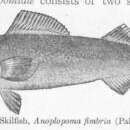Diagnostic Description
(
Anglèis
)
fornì da FAO species catalogs
Body elongate. One lateral line with 190-195 scales, running along body axis. Dorsal fins well separated, the first with 19 to 27 spines; second dorsal fin with 16 to 20 soft rays, subequal to anal in size and form, and opposite in position. Anal fin with 3 spines and 15-19 soft rays. Pectoral with 16. Gillrakers 62-65. Adults (shown) are blackish or greenish gray above; usually with slightly paler blotches or chain-like pattern on upper back; paler below. At 30-61 cm often greenish, with faint stripes on back. Young under 15 cm are blue, black above; white below. Occasionally solid yellow, albino, or other unusual colors.
Amaoka, K. - 1984Anoplopomatidae. In: H. Masuda; K. Amaoka; C. Araga; T. Uyeno; T. Yoshino (eds.). The Fishes of the Japanese Archipelago. Tokai Univ. Press.320.
Distribution
(
Anglèis
)
fornì da FAO species catalogs
From Volcanic Bay, Japan through the Bering Sea to off Southern California.
Size
(
Anglèis
)
fornì da FAO species catalogs
Attains over 100 cm.
Brief Summary
(
Anglèis
)
fornì da FAO species catalogs
Lives on mud bottom at depths between 300 and 600 m or deeper (adults to 1829 m). Young in shallow water.Feeds on crustaceans, worms and small fishes.Often migratory. Spawning occurs the spring. Known to live more than 20 years.
Benefits
(
Anglèis
)
fornì da FAO species catalogs
Caught by trawl net, traps and longlines. The total catch reported for this species to FAO for 1999 was 26 188 t. The countries with the largest catches were USA (21 888 t) and Canada (4 300 t). Mostly quick-frozen and marketed in the Orient. Also utilized fresh, dried/salted and smoked, can be steamed, pan-fried, broiled, boiled, microwaved and baked. Its liver oil is rich in vitamin "A" and "D".

